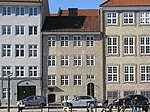Royal Stables (Denmark)
Danish monarchyIndre ByMuseums in CopenhagenMuseums with year of establishment missingSlotsholmen ... and 2 more
StablesTourist attractions in Copenhagen

The Royal Stables (Danish: De Kongelige Stalde) is the mews (i.e., combined stables and carriage house) of the Danish monarchy which provides the ceremonial transport for the Danish royal family during state events and festive occasions. The Royal Stables are located at Christiansborg Palace on the island of Slotsholmen in central Copenhagen, Denmark. In 1789, the number of horses reached a peak with 270 horses stabled. Nowadays, there are about 20 horses in the Royal Stables. The Royal Stables are regularly open to the public and include a small museum. The state coaches and other carriages are kept there, along with about 20 horses.
Excerpt from the Wikipedia article Royal Stables (Denmark) (License: CC BY-SA 3.0, Authors, Images).Royal Stables (Denmark)
Christiansborg Ridebane, Copenhagen Christianshavn
Geographical coordinates (GPS) Address Nearby Places Show on map
Geographical coordinates (GPS)
| Latitude | Longitude |
|---|---|
| N 55.675386111111 ° | E 12.578055555556 ° |
Address
Christiansborg Ridebane
Christiansborg Ridebane
1213 Copenhagen, Christianshavn
Capital Region of Denmark, Denmark
Open on Google Maps











